Coins of the rupiah
Indonesian rupiah coinage was first issued in 1951 and 1952, a year or so later than the first Indonesian rupiah banknotes printed following the peace treaty with The Netherlands, agreed in November 1949. Although revolutionary currency had been issued in by the provisional Republic of Indonesia between the declaration of independent on 17 August 1945 and 1949, it had all been formed of paper, metal being far too scarce for the internationally isolated government to use as currency.
.jpg.webp)
Due to high inflation in the late 1950s and early 1960s, no coins were minted after 1961, and that which remained in circulation was effectively worthless.
A devalued 'new rupiah' was issued in an attempt to tame inflation in 1965, with banknotes in denominations all the way from 1 sen (1 cent) up to 100 rupiah - no coins were struck at this time. By 1971, however, the economy, and inflation, under Suharto's New Order was stable, and coinage was once again issued, in denominations of 1, 5, 10, 25 and 50 rupiah, with 100 rupiah added two years later. Due to inflation, the current coinage now consists of 25, 50, 100, 200, 500 and 1000 rupiah, although older 1 rupiah coins remain officially legal tender for completeness.
Unlike coinage of the Netherlands Indian gulden (which in higher denominations were made of silver or gold), circulating rupiah coinage has always been formed of base metal.
Sen coinage of the rupiah 1951–1961
For the first couple of years until sufficient coins had been issued, government sen notes were circulated, of 10, 25 and 50 sen denominations. No lower denominations were printed, but the old bronze Netherlands Indies gulden coins of 1/2, 1 and 2½ sen remained as legal tender (higher denominations, starting from 1/20 gulden (5 sen) had been silver, with greater intrinsic metal value).
Coinage, issued in 1951 and 1952 and from then until 1961, replaced the notes as sufficient coinage entered circulation. Under Indonesian law originally enacted by the Dutch, issue of money below 5 rupiah (in Dutch times gulden), was the responsibility of the government, and hence all coins bore the name of Indonesia, rather than the central bank.
The denominations were 1, 5, 10, 25 and 50 sen. The 1 and 5 sen coins had centre holes, similar to the old copper coins of the Dutch, while the other coins were solid. All were aluminium except the 50 sen, which was copper-nickel. 1 sen coins were effectively worthless, and only a token number of 100,000 were minted, all dated 1952. 5 sen coins were more useful and were also minted dated 1954, as was the 10 sen.
From 1954, Indonesia began to eliminate use of Malay Arabic script (Jawi), which had been a feature of the coins of the Netherlands Indies as well as of past Islamic sultanates in the archipelago. The 50 sen coin was the first to be changed, with the Arabic text simply removed from the coin for its 1954-dated minting.
The 25 sen was the next to have the Arabic removed, with "INDONESIA" replacing its Jawi equivalent for the second minting of the coin, dated 1955 (the 50 sen was also minted that year).
Inflation meant that the smallest denomination to be minted after 1954 was the 10 sen, which likewise had Arabic removed from its reverse for its third minting, 1957; 25 and 50 sen coins were also minted in 1957.
After 1957, the cupro-nickel 50 sen was debased to aluminium, the same metal as the lower denomination coins (which were never minted again). As a result of this, the 50 sen, previously the heaviest, but second-smallest coin - slightly larger than the 1 sen, was now the largest coin in circulation (albeit lighter than its predecessor).
| First coins of the Indonesian rupiah[1] | ||||||||||
| Image | Technical Data | Description | ||||||||
| Obverse | Reverse | Value | Date | Composition | Diameter | Mass | Edge | Mintage | Obverse | Reverse |
| 1 sen | 1952 | Aluminium | 0.75g | Smooth | 0.1 million | Rice stalk around centre hole, "INDONESIA 1952", "1 SEN", Mintmark of Utrecht (bunch of grapes) and its then Mintmaster (fish) | "Indonesia 1 sen" in Jawi script around centre hole | |||
| 5 sen | 1951, 1954 | 22 mm | 1.3g | Rice stalk around centre hole, "INDONESIA 1951/1954", "5 SEN"; Mint mark and Mint Master's mark on 1951 coin (not on 1954) | "Indonesia 5 sen" in Jawi script around centre hole | |||||
| 10 sen | 1951, 1954, 1957 | 1.72g | Reeded | 50m (1954), 50.2m (1957) | Central scalloped circle with "10 SEN", circumscribed by "INDONESIA 1951/1954/1957", Mint and Master's mark on 1951 coin only | Garuda Pancasila with Indonesia in Jawi (in Latin script on 1957) | ||||
| 25 sen | 1952, 1955, 1957 | 27.7 mm | 2.2g | 200m (1952), 25.8m (1955), 99.8m (1957) | Central scalloped circle with "25 SEN", circumscribed by "INDONESIA 1952/1955/1957", Mint and Master's mark on 1952 coin only | Garuda Pancasila with Indonesia in Jawi (in Latin script on 1955 and 1957) | ||||
| 50 sen | 1952, 1954, 1955, 1957 | Copper-nickel | 3.24g | 100m (1952), 1.3m (1954), 15m (1955), 26.3m (1957) | Central scalloped circle with "50 SEN", circumscribed by "INDONESIA 1952/1954/1955/1957", Mint and Master's mark on 1952 coin only | Diponegoro "DIPA NEGARA" (also in Jawi script on 1952 coin only); text is smaller on 1952 and 1955 coins | ||||
| 50 sen | 1958, 1959, 1961 | Aluminium | 29 mm | 3.02g | 33.7m (1958), 100.0m(1959), 150m (1961) | Large "50" over "SEN" in a large circle, circumscribed by "REPUBLIK INDONESIA 1958/1959/1961" | Garuda Pancasila with text "INDONESIA" | |||
25 rupiah gold coin
A variation of the 1952 50 sen coin was issued in gold with an official value of 25 rupiah (although no value on the coin). The coin varied from the 50-sen by featuring the logo "BEKERDJA-MENABUNG-MEMBANGUN" and the Garuda emblem instead of the year and denomination. Like the other 1951–1952 coins, this one has the mintmark of Utrecht.
One Indonesian ringgit equals 2 1/2 Indonesian rupiah
Indonesians have an old proverb: "SeRinggit Si Dua Kuapang, SeTali Si Tiga Uang" which means: "1 ringgit is 2 kupangs, 1 tali is 3 moneys". The proverb refers to the Indonesian names of coins and currency units before 17 August 1945. As Widarto claims[2] keping also cepeng, hepeng = 1/4 sen (cent), peser = 1/200 rupiah = 1/2 sen, sen = 1/100 rupiah, pincang = 1 1/2 sen[3] but no coin was ever issued in this value, gobang = 1/40 rupiah = 2 1/2 sen, kelip = 1/20 rupiah = 5 sen, ketip also picis, ketit = 1/10 rupiah = 10 sen, tali = 1/4 rupiah = 25 sen = 3 uang which means money, ukan also ukon[4] = 1/2 rupiah = 50 sen, rupiah was a value equal to the 1 guilder of Hindia-Belanda, the Netherlands Indies, kupang = 1/2 ringgit = 1 1/4 rupiah, benggol = seringgit = 1 ringgit = 2 1/2 rupiah = 2 1/2 Netherlands Indies guilder. The uang although it means money in Indonesian was merely a value of 1/3 tali = 8 1/3 sen but no coin was ever issued in this value. The Kupang gave its name to an Indonesian city in southwest of Timor. The coin was made of gold, circulated in Aceh, Sulawesi and Malayan states in some forms, for centuries.
In 1963 Indonesia Issued a coin of 2 1/2 rupiah depicting Sukarno in two forms, one of the coins was intended for West Irian, the other was intended for entire Indonesia, but both coins were minted in very limited quantities. Their values according to Krause catalogue are US$290[5] for the first coin and US$100 for the Irian coin.[6][7][8] While NGC online catalogue evaluate one of the coins as worth US$290.[9] West Irian coin is evaluated as US$100,[10] and never placed into circulation, maybe because of hyperinflation that ruled Indonesian economy in Sukarno era, especially during the years 1959 to 1965.
Rupiah coinage of the Indonesian rupiah: 1971 onwards
1971–1973: reintroduction of coins to Indonesia
With the raging inflation of the 1960s very much under control at this point, coin issuing resumed after a 10-year hiatus, and coins were issued on 1 January 1971, of denominations 1, 2 and 5 rupiah, all in aluminium. 10, 25, and 50 rupiah coins were added, in cupro-nickel, on 5 April 1971. The coins featured on the obverse 'Bank Indonesia' a large '1' with 'rupiah' underneath and the year '1970' (1, 2, and 5 rupiah) or '1971' (10, 25, 50 rupiah).
The reverse of the coins showed "Rp 1", "Rp 5", "Rp 10", "Rp 25", "Rp 50", plus various designs: white-browed fantail (1rp), rice and cotton stalk (2rp), black drongo bird (5rp), rice and cotton stalk with Indonesian wording "TINGKATKAN PRODUKSI SANDANG PANGAN" ("increase the product of clothing and food") (10rp), Victoria crowned pigeon (25rp), and greater bird of paradise (50rp). The final mintages of these coins were: 136 million (1 rupiah), 139 million (2 rupiah), 448 million (5 rupiah), 286 million (10 rupiah), 1.22 billion (25 rupiah) and 1 billion (50 rupiah).
The 10 rupiah coin was issued as part of the UN Food and Agriculture Organization coins and medals program, an international issue by ultimately 114 countries. A variety of coin sets were sold to coin collectors to raise money for the UN's food program. In addition to the sale to collectors, the vast majority of the 10 rupiah coins were used within Indonesia - in addition to some rarer coins (none of which were issued in Indonesia) the FAO wanted low denomination circulating coinage that called for increasing food production.
At the time the exchange rate was 378 rupiah to the US$, so the smallest coin was worth approximately 1/4 of a US cent (note however that the 1 and 2 rupiah coins were never reissued, and hence the 5 rupiah coin was shortly to become the smallest denomination).
The coin selection was extended with a '1973'-dated cupro-nickel 100 rupiah coin of large size showing a Minangkabau tribal house, which was issued on 2 January 1974, at which time the coin was worth about US$0.24. A total of 913 million of these coins were minted, some of which are still found in circulation today.
As a result of the successful re-establishment of coinage in Indonesia, notes below 100 rupiah were withdrawn in Indonesia permanently from 1 September 1975 (at which point the exchange rate was fixed at 415 rupiah to the dollar, hence the largest denomination banknote to be withdrawn, the 50 rupiah note, was worth around US$0.10).
1971 INDONESIAN COINS:
| 50 Indonesian rupiah (1971). | |
|---|---|
.jpg.webp) | |
| Obverse: Greater bird-of-paradise on a branch and face value. | Reverse: Face value surrounded by country and year. |
| Total 1,035,435,000 coins minted in 1971. Coin Demonetized in 2002. | |
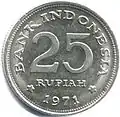 25 rupiah obverse
25 rupiah obverse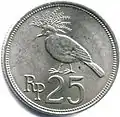 25 rupiah reverse
25 rupiah reverse
1974: coin redesigns
The 5 rupiah aluminium coin was revised dated 1974, the obverse changing only the date, but the reverse depicting the logo of KB ('Keluarga Berencana', aka family planning', a movement first established by the Indonesian government in 1970), i.e. a 2-parent, 2-child family with rice and cotton stalk and letters KB, with the text 'KELUARGA BERENCANA' ('family planning') 'MENUJU KESEJAHTERAAN RAKYAT' ('for the welfare of the people'). 448 million were minted.
The 10 rupiah was enlarged substantially dated 1974, with the composition changed to brass-clad steel, with the obverse unchanged, and the reverse changed to show the symbol of Tabanas, the government's 1970-established national savings scheme, and the slogan 'MENABUNG UNTUK MENUNJANG PEMBANGUNAN' ('save to support development') 223 million were minted.
Both of these coins were also sold to collectors as part of UN FAO sets.
1978–1979: updated coinage
The 1973 100 rupiah was given an updated reverse design in 1978, reading 'HUTAN UNTUK KESEJAHTERAAN' (Forest for welfare), '1978' and a motif of the gunungan wayang. The coin was also made thinner, although its dimensions did not change. This was the fourth and final Indonesian FAO coin.
 100 rupiah 1978 obverse
100 rupiah 1978 obverse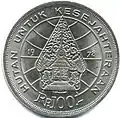 100 rupiah 1978 reverse
100 rupiah 1978 reverse
The 1974 5 rupiah, meanwhile, was updated '1979', issued from March 1980, retaining its family planning message, but adding a circular decoration to both reverse and obverse of the coin, and being shrunk in size from 3.0 to 1.4 grams, presumably to cut the cost of production. 413 million coins were minted dated 1978, while 5 million were later issued dated 1995 and 1996.
The 1974 10 rupiah was similarly updated with decoration to '1979', enlarged with the composition changed to aluminium. 286 million were minted with this date. No 10 rupiah coins have since been issued.
1991: updated coinage
From 1979, no new coin designs were made in Indonesia until 1991. For new coinage, the old style of a large number was replaced instead with the national Garuda Pancasila logo, with the year and "BANK INDONESIA" in smaller text below the emblem.
A 25 rupiah coin dated 1991 in aluminium, with images of nutmeg and its Indonesian text 'buah pala' and "Rp 25" on the reverse, was the smallest coin to be revised. The same coin was also minted 1992–1996, with mintages each year of 30, 64, 20, 250, 185, and 5 million. No 25 rupiah coins have been issued since 1996.
50 rupiah backed with a Komodo dragon and text 'Komodo' was issued in aluminium-bronze, dated 1991, and later 1992, 1993, 1994, 1995, 1996, 1997 and 1998. Mintages were 67, 120, 300, then 590 million, then 150,000 each year.
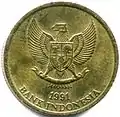 50 rupiah 1991 obverse
50 rupiah 1991 obverse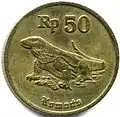 50 rupiah 1991 reverse
50 rupiah 1991 reverse
The 100 rupiah, also aluminium-bronze was inscribed with an octagon, featuring the reverse design of running bulls with the text karapan sapi (bull racing). The coin was minted 1991 through 1998, with respective mintages of 94, 120, 300, 550, 799, 41, 150, and 56 million.
A 500 rupiah coin, also in aluminium-bronze, became the first new coin denomination since 1973, with a value at issue of around US$0.20. The coin depicted on its reverse the jasmine flower with the text "bunga melati". This coin was minted dated 1991 and 1992, with mintages of 71 million then 100 million.
1993: 1,000 rupiah coin introduced
1993 extended the range of coin denominations, adding 1,000 rupiah, then worth around US$0.40 a bimetallic coin of copper-nickel and aluminium-bronze. This coin depicts an oil palm 'kelapa sawit', and was minted 1993, 1994, 1995, 1996, 1997 and 2000.
1997–1999: coin revisions
The 500 rupiah coin was updated '1997' with a smaller jasmine leaf above a large central '500' with smaller lower 'rupiah', and the same aluminium-bronze material. The coin was minted dated 1997, 2000, 2001, 2002 and 2003.
The next coin design, was '1999' 50 rupiah coin, which was struck in aluminium showing the black-naped oriole. As with the 500 rupiah, the reverse of the coin has a larger numerical denomination. Dates are 1999, 2001 and 2002.
The 100 rupiah coin was also altered in the same manner to aluminium from '1999', depicting the palm cockatoo. Mint dates are each year from 1999 through 2005.
2003: coin revisions
The next coin revisions in Indonesia are of 2003.
The 200 rupiah coin in aluminium, depicting the Bali starling 'jalak bali' was introduced as a new denomination in the same style as the 50 and 100 rupiah coins, dated '2003', while the jasmine 500 rupiah coin was again redesigned, with its metal changed to aluminium and its size enlarged.
2016: coin revisions
The most recent coin revisions in Indonesia occurred in December 2016. The new coins were released along with the new banknotes. For the first time, there are actual people depicted in non-commemorative coins. Herman Johannes is depicted for 100 rupiah, Tjipto Mangoenkoesoemo on 200 rupiah, T. B. Simatupang on 500 rupiah, and I Gusti Ketut Pudja on 1,000 rupiah coins.[11]
Circulating coinage of the Indonesian rupiah
There are presently two series of coins in circulation: aluminium bronze and bi-metallic coins from 1991–1998 and light-weight aluminium coins from 1999 onwards. Due to the low value and general shortage of small denomination coins (below 100 rupiah), it is common to receive sweets in lieu of the last few rupiah of change in supermarkets and stores, a practice that is illegal under Indonesian law.[12] The 1 rupiah coin is officially legal tender for completeness' sake, but is not circulated as it is effectively worthless.
| Indonesian rupiah coins[13] | ||||||||||
|---|---|---|---|---|---|---|---|---|---|---|
| Image | Value | Series | Diameter | Thickness | Weight | Material | Obverse | Reverse | Availability | |
| Obverse | Reverse | |||||||||
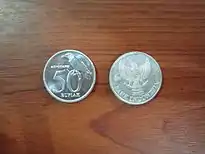 | Rp 50 | 1999 | 20 mm | 2 mm | 1.36 g | Aluminium | Garuda Pancasila | Kepodang bird and coin value | Low | |
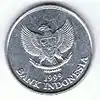 |  | Rp 100 | 1999 | 23 mm | 2 mm | 1.79 g | Palm cockatoo bird and coin value | High | ||
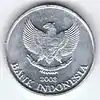 | 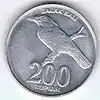 | Rp 200 | 2003 | 25 mm | 2.3 mm | 2.38 g | Bali starling bird and coin value | |||
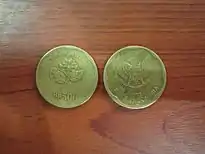 | Rp 500 | 1991 | 24 mm | 1.8 mm | 5.29 g | Aluminium bronze | Jasmine flower and coin value | Low | ||
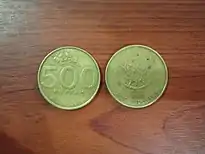 | 1997 | 1.83 mm | 5.34 g | Medium | ||||||
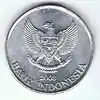 | 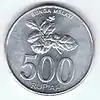 | 2003 | 27 mm | 2.5 mm | 3.1 g | Aluminium | High | |||
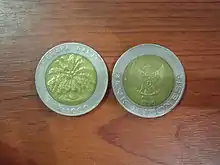 | Rp.1000 (Rare)
Rp.1000 (Common) |
1993 | 26 mm | 2 mm | 8.6 g | Bi-metal, nickel and aluminium bronze | Palm tree and coin value | Low | ||
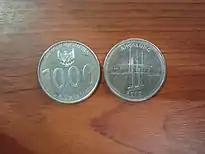 | 2010 | 24.15 mm | 1.6 mm | 4.5 g | Nickel plated steel | Garuda Pancasila and coin value | Angklung and Gedung Sate | High (mintage 719 million) | ||
Commemorative coins
Although circulating coins in Indonesia have never been made from precious metals, a number of special issues have been made since coins were reintroduced to Indonesia in 1970 from either silver or gold. As commemorative coins, they were all sold above their intrinsic value, and also above their nominal value.
All the coins struck are proof coinage, with the exception of the WWF 1974 coinage which were issued in non-proof 50% silver, and proof and non-proof gold.
36,000 gold pieces of the 1952 50 sen were minted that year, with the obverse design replaced with the Garuda Pancasila and text "INDONESIA" "BERKERDJA MENABUNG MEMBANGUN".
With the exception of the WWF and Save the Children issues, which are in good supply, most of the coins are relatively scarce and command good premiums to their bullion value.
The following issues have been made:
| Indonesian Commemorative coins | ||||||||||||
|---|---|---|---|---|---|---|---|---|---|---|---|---|
| Issued | Reason for Issue | Material | Nominal Value | Diameter | Thickness | Purity | Weight | Obverse | Reverse | Mintage limits | Notes | AGW/ASW (troy ounces) |
| 1970 | 25 years of Independence | Silver | Rp 200 | 0.999 | 8g | "1945–1970" "200 RUPIAH" "1970" Garuda Pancasila | "REPUBLIK INDONESIA" "25 TAHUN KEMERDEKAAN" greater bird of paradise | 5100 | 0.2569 | |||
| Rp 250 | 10g | "1945–1970" "200 RUPIAH" "1970" Garuda Pancasila | "REPUBLIK INDONESIA" "25 TAHUN KEMERDEKAAN" Statue of Manjusri from Tumpang Temple, Malang | 5,000 | 0.3212 | |||||||
| Rp 500 | 20g | "1945–1970" "500 RUPIAH" "1970" Garuda Pancasila | "REPUBLIK INDONESIA" "25 TAHUN KEMERDEKAAN" Female Wayang Dancer | 4,800 | 0.6423 | |||||||
| Rp 750 | 30g | "1945–1970" "750 RUPIAH" "1970" Garuda Pancasila | "REPUBLIK INDONESIA" "25 TAHUN KEMERDEKAAN" Balinese eagle carving | 4,950 | 0.9635 | |||||||
| Rp 1,000 | 40g | "1945–1970" "1000 RUPIAH" "1970" Garuda Pancasila | "REPUBLIK INDONESIA" "25 TAHUN KEMERDEKAAN" Soedirman | 4,250 | 1.2847 | |||||||
| Gold | Rp 2,000 | 18 mm | 0.900 | 4.93g | "1945–1970" "2000 RUPIAH" "1970" Garuda Pancasila | "REPUBLIK INDONESIA" "25 TAHUN KEMERDEKAAN" greater bird of paradise | 2,970 | Year coins restarted in Indonesia | 0.1426 | |||
| Rp 5,000 | 30 mm | 12.34g | "1945–1970" "5000 RUPIAH" "1970" Garuda Pancasila | "REPUBLIK INDONESIA" "25 TAHUN KEMERDEKAAN" Statue of Manjusri from Tumpang Temple, Malang | 2,150 | 0.3571 | ||||||
| Rp 10,000 | 40 mm | 24.68g | "1945–1970" "10000 RUPIAH" "1970" Garuda Pancasila | "REPUBLIK INDONESIA" "25 TAHUN KEMERDEKAAN" Female Wayang Dancer | 1,440 | 0.7141 | ||||||
| Rp 20,000 | 50 mm | 49.37g | "1945–1970" "20000 RUPIAH" "1970" Garuda Pancasila | "REPUBLIK INDONESIA" "25 TAHUN KEMERDEKAAN" Balinese eagle carving | 1,285 | 1.4285 | ||||||
| Rp 25,000 | 54 mm | 61.71g | "1945–1970" "25000 RUPIAH" "1970" Garuda Pancasila | "REPUBLIK INDONESIA" "25 TAHUN KEMERDEKAAN" Soedirman | 970 | 1.7855 | ||||||
| 1974 | WWF endangered animals awareness | Silver | Rp 2,000 | 38.61 mm | 2.75 mm | 0.925 | 28.28g | "BANK INDONESIA" "1974" Garuda Pancasila | Javan tiger "Rp 2000" | 18,000 proof | Coins minted by Royal Mint. Similar coins issued in 11 other countries | 0.841 |
| 0.500 | 25.65g | 43,000 | 0.4123 | |||||||||
| Rp 5,000 | 42 mm | 2.87 mm | 0.925 | 35.00g | Orangutan "Rp 5000" | 17,000 proof | 1.0408 | |||||
| 0.500 | 32.00g | 43,000 | 0.5144 | |||||||||
| Gold | Rp 100,000 | 34 mm | 2.49 mm | 0.900 | 33.437g | Komodo dragon "Rp 100000" | 5,333 plus 1,369 proof | 0.9675 | ||||
| 1987 | WWF 25 years | Silver | Rp 10,000 | 36 mm | 0.925 | 19.44g | "BANK INDONESIA" "1987" Garuda Pancasila | Babirusa "Rp 10000" | 25,000 | Minted by Royal Mint. Similar coins issued in 16 other countries | 0.5781 | |
| Gold | Rp 200,000 | 25 mm | 0.917 | 10g | Javan rhinoceros "Rp 200000" | 5,000 | 0.2948 | |||||
| 1990 | 70 Years of Save The Children | Silver | Rp 10,000 | 36 mm | 0.925 | 19.44g | "BANK INDONESIA" "1990" Garuda Pancasila | "SAVE THE CHILDREN" "10000 RUPIAH" 2 Children playing badminton | 20,000 | Similar coins in 22 other countries | 0.5781 | |
| Gold | Rp 200,000 | 25 mm | 0.917 | 10g | "SAVE THE CHILDREN" "200000 RUPIAH" Balinese Dancer | 3,000 | Similar coins in 12 other countries | 0.2948 | ||||
| 1990 | 45 Years of The Republic | Gold | Rp 125,000 | 0.9583 | 8g | Garuda Pancasila "1990" "BANK INDONESIA | Museum Joang 45 (Museum of Struggle) "125000 RUPIAH" | 16,000 | 0.2464 | |||
| Rp 250,000 | 17g | "NUSANTARA" "1945–1990" "250000 RUPIAH" Map of Indonesia | 16,000 | 0.5236 | ||||||||
| Rp 750,000 | 45g | Garuda Pancasila with text "ANGKATAN 45" and wreath of rice and cotton. "750000 RUPIAH" | 16,000 | 1.386 | ||||||||
| 1995 | 50 years of The Republic | Gold | Rp 300,000 | 25 mm | 1.85 mm | 17g | "BANK INDONESIA" "1995" "300000 RUPIAH" Garuda Pancasila | "50 TAHUN R.I." Soeharto speaking to the people | 3,000 sets | 0.5237 | ||
| Rp 850,000 | 35 mm | 2.78 mm | 50g | "BANK INDONESIA" "1995" "850000 RUPIAH" Garuda Pancasila | "LIMA PULUH TAHUN KEMERDEKAAN REPUBLIK INDONESIA" Soeharto | 1.5404 | ||||||
| 1999 | 50 Years of UNICEF | Silver | Rp 10,000 | 38.61 mm | 0.925 | 28.28g | "BANK INDONESIA" "1999" Garuda Pancasila | "FOR THE CHILDREN OF THE WORLD" "Rp 10000" Boy and Girl Scout planting one of a million trees | 25,000 | Similar coins issued in other countries | 0.841 | |
| Gold | Rp 150,000 | 22 mm | 0.9999 | 6.22g | "FOR THE CHILDREN OF THE WORLD" "Rp 150000" Boy on kuda lumping (Javanese bamboo horse for dancing) | 10,000 | Similar coins issued in other countries | 0.1998 | ||||
| 2001 | 100 years since birth of 'Bung Karno' | Silver | Rp 25,000 | 38.61 mm | 0.925 | 28.28g | "BANK INDONESIA" "2001" Garuda Pancasila | "100 TAHUN BUNG KARNO (1901–2001)" "Rp 25000" Sukarno in profile | 500 | 0.841 | ||
| Gold | Rp 500,000 | 28.2 mm | 0.9999 | 15g | "100 TAHUN BUNG KARNO (1901–2001)" "Rp 500000" Sukarno facing | 500 | 0.4818 | |||||
| 2002 | 100 years since birth of 'Bung Hatta' | Silver | Rp 25,000 | 38.61 mm | 0.925 | 28.28g | "BANK INDONESIA" "2002" Garuda Pancasila | "SATUABAD BUNG HATTA (1902–2002)" "Rp 25000" Hatta looking left | 2,000 | 0.841 | ||
| Gold | Rp 500,000 | 28.2 mm | 0.9999 | 15g | "SATUABAD BUNG HATTA (1902–2002)" "Rp 500000" Hatta looking right | 2,000 | 0.4818 | |||||
References
- Bruce, Colin R. II (senior editor) (2007). 2008 Standard Catalog of World Coins: 2001–Date (2nd ed.). Krause Publications. ISBN 0896895017.
- http://wdarto.wordpress.com/2008/01/03/asal-muasal-setali-tiga-uang-seringgit-si-dua-kupang/ in Indonesian Language
- http://valentinusadinugraha.blogspot.co.il/2013/02/sejarah-mata-uang-indonesia-rupiah.html in Indonesian Language
- http://aveesienadinar.blogspot.co.il/2010/04/jejak-mata-uang-emas-dan-perak-di.html in Indonesian Language
- Standard Catalog Of World Coins 2016 edition, page 1153 reference number Pn3, here: https://books.google.com/books?id=lCFsCQAAQBAJ&printsec=frontcover&source=gbs_ge_summary_r&cad=0#v=onepage&q&f=false
- Obverse Photograph: http://giladzuckermanbeitarfan.homestead.com/files/seringgit_si_dua_kupang_pn3_1963_0.jpg
- Reverse Photograph http://giladzuckermanbeitarfan.homestead.com/files/seringgit_si_dua_kupang_pn3_1963_R.jpg
- Source For both coins values US$250 and US$100 according to the Krause catalog, Pages 1138, 1139: , p. 1139, at Google Books
- Source for value and photographs: http://www.ngccoin.com/price-guide/world/indonesia-2-1-2-rupiah-km-pn3-1963-cuid-50104-duid-136048
- http://www.ngccoin.com/price-guide/world/indonesia-irian-barat-2-1-2-rupiah-km-pn2-1963-cuid-49535-duid-134568
- Release poster of 2016 emission notes and coins
- Bie, Song Je (20 August 2010). "Disperindag: Uang Kembalian Permen Rugikan Konsumen (Disperindag: Giving candies instead of changes harms consumers)". ANTARA News (in Indonesian). Retrieved 21 January 2021.
- Instrumen Tunai. Bank Indonesia
